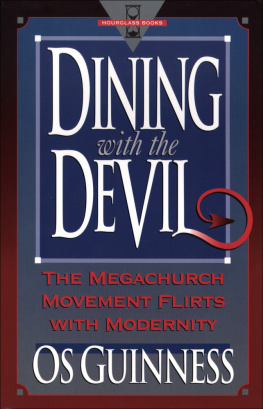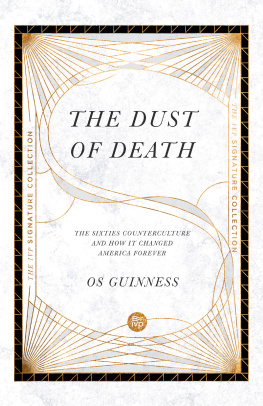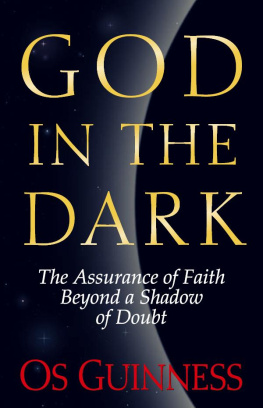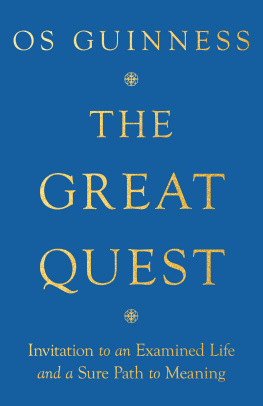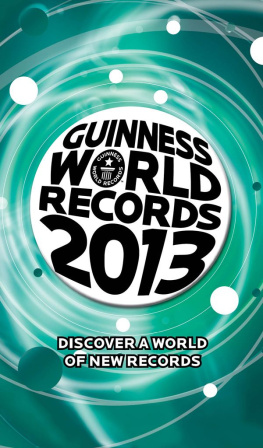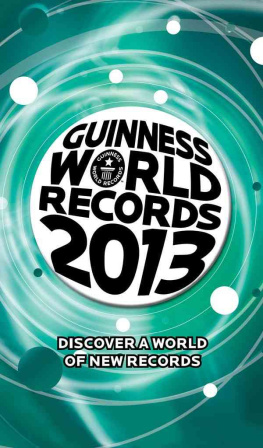Os Guinness - Dining with the Devil: The Megachurch Movement Flirts with Modernity
Here you can read online Os Guinness - Dining with the Devil: The Megachurch Movement Flirts with Modernity full text of the book (entire story) in english for free. Download pdf and epub, get meaning, cover and reviews about this ebook. year: 1993, publisher: Baker Publishing Group, genre: Religion. Description of the work, (preface) as well as reviews are available. Best literature library LitArk.com created for fans of good reading and offers a wide selection of genres:
Romance novel
Science fiction
Adventure
Detective
Science
History
Home and family
Prose
Art
Politics
Computer
Non-fiction
Religion
Business
Children
Humor
Choose a favorite category and find really read worthwhile books. Enjoy immersion in the world of imagination, feel the emotions of the characters or learn something new for yourself, make an fascinating discovery.
- Book:Dining with the Devil: The Megachurch Movement Flirts with Modernity
- Author:
- Publisher:Baker Publishing Group
- Genre:
- Year:1993
- Rating:3 / 5
- Favourites:Add to favourites
- Your mark:
- 60
- 1
- 2
- 3
- 4
- 5
Dining with the Devil: The Megachurch Movement Flirts with Modernity: summary, description and annotation
We offer to read an annotation, description, summary or preface (depends on what the author of the book "Dining with the Devil: The Megachurch Movement Flirts with Modernity" wrote himself). If you haven't found the necessary information about the book — write in the comments, we will try to find it.
What shapes the message of the church? The Bible and Spirit? Or society and culture? Os Guinness points out perils of compromise in the church growth movement.
Os Guinness: author's other books
Who wrote Dining with the Devil: The Megachurch Movement Flirts with Modernity? Find out the surname, the name of the author of the book and a list of all author's works by series.
Dining with the Devil: The Megachurch Movement Flirts with Modernity — read online for free the complete book (whole text) full work
Below is the text of the book, divided by pages. System saving the place of the last page read, allows you to conveniently read the book "Dining with the Devil: The Megachurch Movement Flirts with Modernity" online for free, without having to search again every time where you left off. Put a bookmark, and you can go to the page where you finished reading at any time.
Font size:
Interval:
Bookmark:
OS GUINNESS
DINING WITH THE DEVIL
The Megachurch Movement Flirts with Modernity
An Hourglass Book

1993 by Os Guinness
Published by Baker Books
a division of Baker Publishing Group
P.O. Box 6287, Grand Rapids, MI 49516-6287
www.bakerbooks.com
Ebook edition created 2012
All rights reserved. No part of this publication may be reproduced, stored in a retrieval system, or transmitted in any form or by any meansfor example, electronic, photocopy, recordingwithout the prior written permission of the publisher. The only exception is brief quotations in printed reviews.
ISBN 978-1-5855-8602-8
Library of Congress Cataloging-in-Publication Data is on file at the Library of Congress, Washington, DC.
Unless otherwise indicated, Scripture quotations taken from the Holy Bible, New International Version . Copyright 1973, 1978, 1984 by International Bible Society.
Cover by Eric Walljasper
He who sups with the devil had better have a long spoon. The devilry of modernity has its own magic: The [believer] who sups with it will find his spoon getting shorter and shorteruntil that last supper in which he is left alone at the table, with no spoon at all and with an empty plate. The devil, one may guess, will by then have gone away to more interesting company.
Peter L. Berger
A Rumor of Angels
Table of Contents
INTRODUCTION
W HEN THE M ALL OF A MERICA opened in Minneapolis in August 1992, enthusiasts hailed it as one of the seven wonders of the modern world. The largest, fully enclosed retail and entertainment complex in North America, its statistics were mind-boggling. It boasted enough floor space to fill eighty-eight football fields. It hired twice the number of workers employed by the city of Minneapolis. It anticipated 40 million annual visitorsnine times the population of Minnesotaand its first-year budget was twice that of the city of St. Paul. Nicknamed the megamall by Minnesotans, it drew screams, gasps, and tears from those who saw it for the first time.
But the strongest attraction of the new Mall of America was the special services that came with its four hundred shops. These included Camp Snoopy, a seven-acre amusement park complete with a roller coaster, an eighteen-hole miniature golf course, numerous customer services, such as cellular phones for separated shoppers, and the ultimate special servicea church service in the rotunda between Bloomingdales and Sears. A Sunday Mallelujah! cried the Minneapolis Star Tribune as six thousand flocked to the opening service organized by Wooddale Church of Eden Prairie.
Many people were enthusiastic. The service was one of the most enterprising and innovative they had ever seen. But others were shocked. A worship service no more has a place in a shopping mall than in a bar or a nightclub. My own view lies with the former, but both reactions missed a deeper point: The problem is not the presence of a church in a mall but the presence of the mall in the church.
The natural association of the megamall and the three-thousand-member megachurch was precisely what the pastors of Wooddale Church had in mind. The symbolism was perfect: Modern megachurches have been built on the philosophical and structural pattern of Americas recent shopping malls, which, in turn, have long been described as cathedrals of consumption. The local press described Wooddale Church as a kind of mega-mall of suburban soulsaving. Yes, said the pastor with a keen appreciation of his win-win relationship with the megamall, Were going to bring the mall a lot of business. Weve suggested to our people that they wear comfortable clothes in which to do any shopping they have in mind after lunch.[]
Wooddale Churchs initiative is an example of one of Americas most prominent religious movements in the 1990seffective evangelism through such modern means of growing churches as management, marketing, and megachurches. Megachurch has joined megabucks, megatrends, and the mega-mall as common American jargon. Megachurches, churches-for-the-unchurched with congregations over two thousand, are widely touted as the inside track to fast growth and a leading trend of the coming millennium. The United States is now said to have over three hundred such megachurchesnearly fifty with over five thousand in attendanceand experts predict that five hundred will exist by A . D . 2000.
One-stop shopping is a theme common to all of the megachurches. The biggest offer not only spiritual attractions but such features as movie theaters, weight rooms, saunas, roller rinks, and racquetball courts. Once a growing church reaches the critical mass of one thousand, the sky is the limit for its financial and organizational potential for further growth through a myriad of dazzling modern insights and technologies.
The modern megachurches are a prominent new feature of the church-growth movement. Many people identify this movement narrowly with the specific architects and advocates of its earlier stagesmost famously, Donald MacGavran, C. Peter Wagner, and the Charles E. Fuller Institute of Evangelism and Church Growth School. Others identify the movement with the most visible examples of its current successmost recently, such best-sellers as George Barnas The Frog in the Kettle, Marketing The Church, and User-Friendly Churches. But the burgeoning megachurches should be included too, epitomized by those on the top ten list, such as Garden Grove Community Church in southern California and Willow Creek Community Church in northwest suburban Chicago.
Thus as I use the term church growth, all these individuals and churches are part of a much wider and more important movement that is linked by a series of underlying commitments: to Christian renewal through renewal of the church, as opposed to politics or the culture; to renewal of the church through renewal of the local church, as opposed to the denomination or parachurch ministry; to the renewal of the local church through the renewal of mission, as opposed to other priorities; and, most importantly, to the renewal of mission along one of two avenuesthrough charismatic renewal or through the employment of the behavioral sciences insights and tools to aid effective evangelism. In this final area, which is the focus of this critique, proponents use tools from the fields of management, marketing, psychology, and communications as they seek to grow churches. Viewed in this broader way, the church-growth movement is a back to basics movement with a special modern twist.
The basic goals of the megachurches and the broader church-growth movement are laudable, ambitious, and significant for the church of Christ around the world. As C. Peter Wagner states them, they are to make more effective the propagation of the gospel and the multiplication of churches on new ground and thus to seeing America evangelized in our generation.[]
Leaving aside for the moment the unexplained new ground, no follower of Christ can quarrel with this basic purpose. But can the movement attain these goals? Will it change the landscape of American religion? Will its passion for mission and effective evangelism lead to a harvest of new Christians and reverse the secularization of the West? Will its innovations amount to a reformation in the worldwide church? Can the secrets of successful megachurches be carried over to struggling small churches?
Like most Christians, my own response to these questions would be a heartfelt prayer of support. But in our enthusiasm we must not be swept away and forget to ask two more important questions. What is the church-growth movements so-called new ground? And are most proponents of church growth and the megachurches even aware of how new ground influences the movement?
Next pageFont size:
Interval:
Bookmark:
Similar books «Dining with the Devil: The Megachurch Movement Flirts with Modernity»
Look at similar books to Dining with the Devil: The Megachurch Movement Flirts with Modernity. We have selected literature similar in name and meaning in the hope of providing readers with more options to find new, interesting, not yet read works.
Discussion, reviews of the book Dining with the Devil: The Megachurch Movement Flirts with Modernity and just readers' own opinions. Leave your comments, write what you think about the work, its meaning or the main characters. Specify what exactly you liked and what you didn't like, and why you think so.

